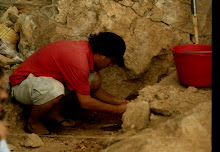Of more direct Paleolithic import was Straus' discussion of some of the Magdalenian art found in the cave. This includes notably the following scapula bearing an incised deer

This is a motif that has been found on similar incised artifacts in other neighboring sites, and bears resemblance to parietal depictions of deer found in neighboring Magdalenian sites as well. This has enabled Straus and his colleague to hypothesize the existence of a relatively tightly bound cultural network defined, among other things, on the basis of shared iconography and stylistic conventions. 16,000 years ago. Very, very neat stuff.
In addition, a sondage at the bottom of the excavated area has revealed the presence of a (so far) undifferentiated Early Upper Paleolithic level dated to about 27 kya (uncalibrated) and Late Mousterian levels going back to 41 kya (uncalibrated). Unfortunately, these lower levels are not very well-known yet, having only been excavated over a very small area, but they're there, which is cool in and of itself. All in all, a fantastic site, one which really gives a good view of diachronic changes in site function, land-use patterns, and 'cultural' traditions. Presented with Straus' usual flair and engaging style (not to mention his intimate familiarity with the Paleolithic record of northern Spain), this was one very informative and very entertaining lecture.

1 comment:
Hey Julien - good to see you up and running again - I was wondering if you had any further details on the talk by Laurence Straus which you mention, i.e. was it transcribed or written up anywhere? Cheers, Tim
Post a Comment